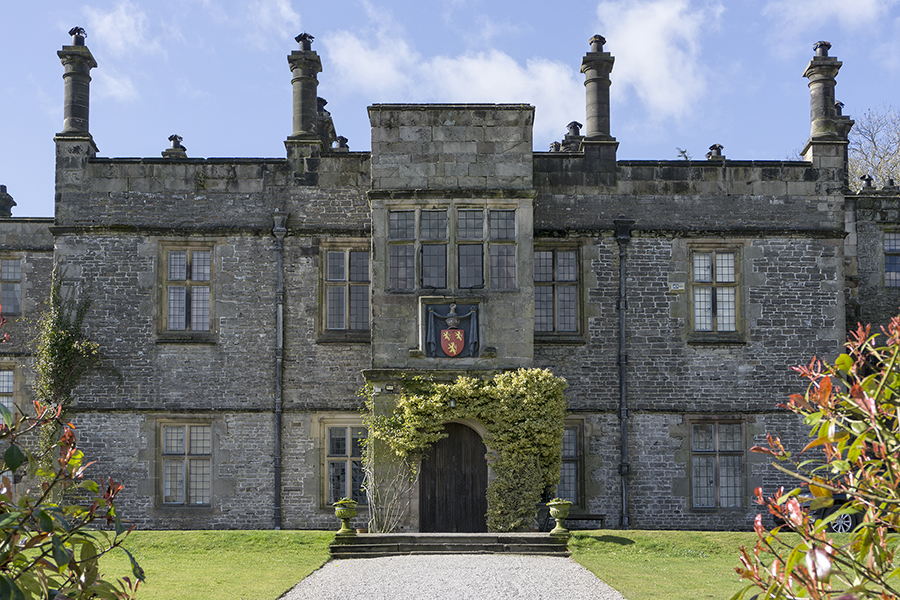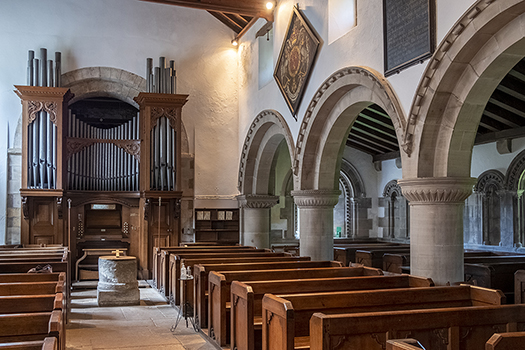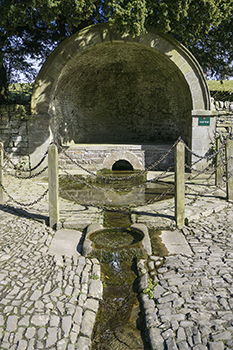 |
| Tissington Hall central block |
 |
| The frontage of the Hall seen from the road |
Tissington Hall is a Grade II* listed building. A moated manor house was replaced by the current house in 1609 by Francis FitzHerbert. Pevsner describes Tissington Hall as a square Jacobean house with a walled garden in front. It has upright mullion-and-transom-cross windows and a parapet, as clearly seen in my first picture. The largest room on the ground floor is placed centrally and at right angles to the façade in the manor of Hardwick. Earlier houses usually had the dining hall parallel to the façade but the new fashion for symmetrical frontages did not fit with this arrangement.
 |
| Tissington Hall central block |
 |
| The frontage of the Hall seen from the road |
Celtic and Anglo-Saxon burial sites were identified at Tissington in the 19th century. The Domesday survey of 1086 records that Tissington was in the possession of Henry de Ferrers. Later it passed to the Savage family.
The Fitzherbert family have lived at Tissington for more than 400 years. The baronetcy was created in 1784 for William Fitzherbert. The family is descended from a Norman knight and they are related to the Fitzherberts of Swynnerton Hall in Staffordshire. In 1125 (reign of Henry III) William FitzHerbert was granted the tenancy of Norbury in Derbyshire. From the Norman Conquest, Norbury was held by Henry de Ferrers but in 1076 he gave the manor to Tutbury Priory. In 1444, Nicholas Fitzherbert and his son Ralph purchased Norbury from the priory and held it until 1881. The Fitzherberts acquired Tissington by the marriage of Nicholas FitzHerbert, the second son of John Fitzherbert of Somersal Herbert to Cicely Frauncis, the heiress of Tissington in 1465.
Monuments to member of the family are to be found in the church including the two that I show in the panel below. The two tiered monument with effigies show Francis Fitzherbert (1619) and his two wives in the Tudor fashion on the lower level, with his son, Sir John (1643) and his wife above in the Stuart manner.
Not shown is a monument to Alleyne Fitzherbert, Baron St. Helens, a famous diplomat. Alleyne was the fifth and youngest son of William Fitzherbert of Tissington and his wife May Littleton Poyntz Meynll of Ashbourne. William Fitzherbert was an MP for Derby and Commissioner of the Board of Trade but took his own life as a result of money problems in 1772. He had been a friend of Dr. Johnson. Alleyne was born in 1753 and educated first at Derby School (1763-66) then at Eton (1766-70) and at St. John's College, Cambridge from 1770 to 1774. Alleyne was recognised as a brilliant intellect; he came second in the mathematical tripos and was also the senior chancellor's medallist.
After graduating, he spent a great deal of his life abroad, much of it as a diplomat. In 1777, he was appointed the British minster at Brussels, remaining until 1782. He was then sent to Paris as plenipotentiary to negotiate a peace between France, Spain and the States General of the United Provinces. He was also closely involved in the peace treaty which ended the American War of Revolution. He was promoted in 1783 to be envoy extraordinary to the Empress Catherine of Russia and accompanied her on a tour of the Crimea in 1787. He was Chief Secretary for Ireland in 1789 and a member of the Privy Council from 1787. He then became Minister plenipotentiary in Spain from 1790 to 1794. The climate there did not agree with him and he became ambassador at the Hague until its conquest by France in the Revolutionary and Napoleonic Wars. He was appointed Baron St. Helen's in the Irish Peerage in 1791. His friend, the explorer, George Vancouver, named Mount St. Helen's after him in 1792.
On 16 July 1797, his house was completely destroyed by fire and he only just escaped with his life. For a man of his interests, the loss of his papers, books and pictures must have been a devastating blow. In 1801, he went on his last official foreign assignment to St. Petersburg to congratulate the Emperor Alexander I of Russia on his accession to the throne and to negotiate a treaty between England and Russia. As a result, he was promoted from an Irish peerage to a peerage of the United Kingdom, as Baron St. Helen's in the Isle of Wight. He died in London on 19 February 1839; he never married and so the title became extinct and his property passed to his nephew, Sir Henry Fitzherbert, 3rd Baronet (1783-1858).
Alleyne's elder brother William (1748-1791) became the first baronet. He was a lawyer and owned plantations for sugar and coffee in Jamaica and Barbados. Their maternal grandmother was Judith, daughter of Thomas Alleyne of Barbados. The Alleynes were among the early settlers of Barbados and became slave owners.
 |
 |
|
| St. Mary's Tissington | St. Mary's from the South-East | |
 |
 |
|
| Detail of East Window | Altar and East Window | |
 |
 |
|
| Organ at west end with font, 2021 | View to the west with the Norman style arcade, 2021 | |
 |
 |
|
| The pulpit by the chancel arch, 2021 | The Norman Chancel Arch | |
 |
 |
|
| Tombs at the front of the nave | Tomb of Sir John Fiztherbert from 1642 | |
 |
 |
|
| Hall Well | Tomb of Francis Fitzherbert from 1619 | |
 |
 |
|
| The Norman font, 2021 | The Village Hall |
 |
||
| Village view by the Duck Pond, 2021 |
Tissington is well-known for its Well Dressing. There are five wells, which can be visited in a circular tour. They are Hands Well, which takes its name from people who once lived nearby; Hall Well opposite the hall itself; Town Well; Yew Tree Well and Coffin Well, named from the shape of the trough. Well-dressing commences on the eve of Ascension Day when the floral displays are erected. Each is made from leaves and petals pressed into clay to make a mosiac picture. Often these had religious themes but in recent years well-dressing has addressed modern topics and commemorations. On Ascension Day, there is a service in the church followed by a tour of the wells with hymns or psalms being sung at each, a prayer offered and the water blessed by the vicar. This is a fine example of how Christianity absorbed the earlier pagan fascination with water, springs and wells.
St. Mary's, Tissington, is not all it seems. Pevsner, in his Buildings of England, describes it as "sadly Normanised in 1854 to match the broad Norman tower". He is referring to the addition of the north aisle. The chancel arch is Norman as is the huge tub-shaped font with animals outlines carved upon it. The porch covers a Norman doorway with a tympanum.
The Buildings of England, Derbyshire, by Nikolaus Pevsner,
revised by Elizabeth Williamson, Yale University Press, 2002, ISBN
0-300-09591-0
The King's England, Derbyshire, by Arthur Mee, first published
in 1937, 6th impression 1951
Derbyshire Parish Churches from the eighth to the eighteenth centuries, by John Leonard, Breedon Books, Derby, 1993
Wikipedia Article on Alleyne Fitzherbert